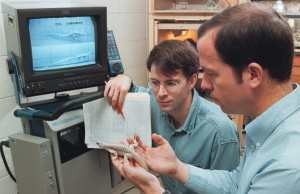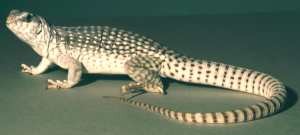Research
Research Interests

I am interested in attempting to understand the evolution of complex systems that involve a combination of behavior, physiology and morphology. I believe that using a comparative, functional and experimental approach combined with an ecological perspective provides the rigor necessary for studying evolutionary adaptation. Snakes have been one convenient group for me to address this question because specialized function has resulted in convergent evolution of behavior and morphology among several lineages within snakes. However, I am also studying a wider variety of vertebrate taxa to achieve the long term goal of a very general understanding of the evolutionary interrelationships between behavior and morphology in complex systems such as those involved in locomotion.
Snakes
A large portion of my previous work has dealt with the proximate functional consequences of morphological variability and the extent of behavioral plasticity for snake locomotion. For example, the comparative anatomy of axial skeleton and muscles in snakes reveals some clear patterns of morphological variability that are associated with behaviorally specialized modes of locomotion. I developed quantitative methods to clarify the kinematics of these locomotor behaviors and to compare performance among different locomotor behaviors and species. I have used electromyography to determine the muscular mechanisms of different locomotor behaviors within a single species as well comparing neural control of the same locomotor behavior between species with different anatomy.
Past research with Al Bennett (University of California, Irvine) combined laboratory testing of locomotor performance (speed and endurance) with a mark and recapture study of a wild population of garter snakes to correlate directly locomotor capacity with survivorship. I hope to combine future field studies with additional laboratory observations to clarify even further the relative importance of speed and locomotor behavior both within and among different species of vertebrates. Collaborative work with Harold Voris (Field Museum of Natural History, Chicago) has examined the feeding behavior and natural history of marine snakes in southeast Asia. Secondary invasion of the marine habitat has occurred independently in at least four different lineages of snakes which can all be found at a single site in Malaysia. Hence, we have attempted to clarify how this diversity at a single site is accommodated by differences in microhabitat and diet.
Presently, I am focusing primarily on the performance and and axial motor patterns involved in the arboreal locomotion of snakes. In addition to the challenges of maintaining balance and preventing slipping on cylindrical surfaces of varying diameter and incline (Astley & Jayne, 2007; video), snakes in arboreal environments often must cross gaps, which can also be a very challenging task (Jayne & Riley, 2007; video). The combination of the structural variation in arboreal habitats and the phylogenetic diversity of snakes that have become arboreal specialists creates a rich diversity of environmental, anatomical and behavioral diversity and be studied to gain fundamental insight into some of the ecologically relevant consequences of variation in musculoskeletal design.
Fish
In collaborative work with George Lauder at University of California, Irvine, I have studied the kinematics and neuromuscular control of the swimming in two species of fish (largemouth bass and bluegill sunfish) belonging to a well-defined monophyletic group. Besides clarifying the role of peripheral morphology on motor output, carefully examining the changes associated with of locomotor speed has provided considerable insights into fiber type recruitment of muscle.
Lizards

Past research with my post-doc Duncan J. Irschick involved the limbed locomotion of lizards. Generalized species of lizards have "sprawling" limb posture that differs considerably from the better-studied upright limb postures of bird and mammals. However, lizard taxa such as chameleons and geckos have limb postures that depart considerably from the generalized condition for lizards. Thus, we can examine the extent to which evolutionary specializations in anatomy may have involved concomitant changes in neural control. Besides interspecific variation in limb function, individual lizards commonly have considerable behavioral variation for moving: 1) over a wide range of speeds, 2) quadrupedally and bipedally , 3) uphill and downhill. Thus, we investigated motor pattern, movement and performance for these diverse behaviors in order to determine the extent to which these behaviors differ fundamentally and have consequences for whole animal performance. Although lizards have often served as a model organisms for studying locomotor performance, the functional basis of differences in performance has barely been examined for these animals. Consequently, our data have clarified some of the causal factors that may underlie conspicuous differences in locomotor capacity.
Research Equipment & Facilities
The following are some of the key items that enable me to obtain and analyze synchronized records of movement and muscle activity.
A high-speed video system (NAC HSV-500) can acquire images at rates of 250 or 500 per second. The two-camera high-speed video unit has a wave inserter that can superimpose an analog trace onto the video images, and the size and position of the images from different cameras can adjusted in both the vertical and horizontal directions. Two synchronized strobe units can provide sufficient illumination to videotape small ectotherms without the overheating the animals.
Electromyography instrumentation includes a TEAC XR-7000 (21 channel FM data recorder), 16 Grass P511K amplifiers, an analog 4-channel oscilloscope, and an 8-channel Gould Model RS 3800 chart recorder.
A variable-speed motorized treadmill (tread area approximately 1.5 by 3 feet) is used to control the speed of small to moderate sizes of terrestrial animals. The treadmill surface can be rotated to simulate uphill and downhill locomotion, and speed can be varied from approximately 0 to 18 miles per hour.
Several PC-compatible computers with custom software are used for analog to digital conversion and analysis of electromyograms (up to 16 channels) and for frame-by-frame analysis of video images. The software for digitizing video images (Datacrunch Inc., San Clemente, California phone: (714) 492-2301) includes options for the three-dimensional analysis of movements recorded with the two-camera setup.